Arthur Mee (1875-1943) was one of the most successful children’s non-fiction writers of the first four decades of the 20th century. His name is now almost forgotten but, in his time, I think it is fair to say that everybody knew him. He was the literary editor of Alfred Harmsworth’s Daily Mail from 1903 until his death in 1943 and he collaborated with Harmsworth on a number of publications like The Self-Educator (1905-7), and The History of the World (1907-9). Perhaps his greatest talent was his ability to organize a huge and diverse amount of general knowledge and disseminate it to the general public (in particular, children) in ways which stimulated their imaginations and kept them coming back for more.
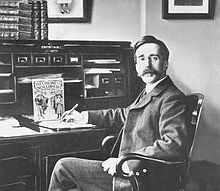
Arthur Mee at his desk with ‘The Children’s Newspaper’, courtesy of Wikipedia
His Children’s Encyclopaedia, published in fifty fortnightly parts between 1908 and 1915 was popular with children, parents and educationalists alike. It was translated into many languages, including Chinese. Its companion, The Children’s Newspaper (1919-1964) was read across the Empire. Mee’s style was accessible and the breadth of his interests was impressive. His collection of over a quarter of a million cross-referenced articles on a huge variety of subjects became famous.
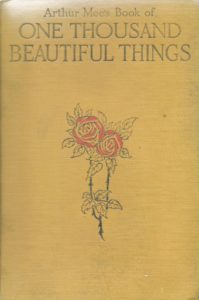
Arthur Mee’s Book of IOOO BEAUTIFUL THINGS
In 1925 Hodder & Stoughton published Arthur Mee’s Book of IOOO BEAUTIFUL THINGS, comprising 320 pages of poems, short articles, lots of excellent, often very atmospheric, photographs, and snippets of literature and history from various countries across the world – and I have my mother’s copy.
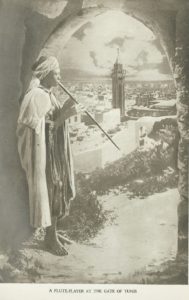
The Flute-player at the Gate of Tunis
IOOO BEAUTIFUL THINGS opens with a 15 page index with impressive cross-referencing. Take the poet, P. B. Shelley. He has six references under S; his poem To a Skylark, has its own entry under T; as does its first line Hail to thee, blithe spirit, under H. It’s very easy to find something in 1000 Beautiful Things. And those of you who have to wrestle with indexes in your jobs will know how rare really good indexes are.
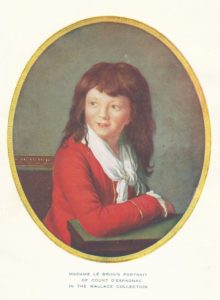
Madame Lebrun’s Portrait of Count D’Espagnac in the Wallace Collection
This is followed by the Pictures’ index comprising over 110 images. The frontispiece is Elisabeth Vigée Lebrun’s portrait of the Comte D’Espagnac in the Wallace Collection, in colour. The other photographs are black and white, and cover a large range of subjects from Old Masters; sculptures; famous buildings of architectural interest, for example The Approach to the Court of Lions at the Alhambra, Granada; picturesque people in exotic places, like The Flute-player at the Gate of Tunis; a couple of nature photographs; and several pages of multi-photographs, such as A Little Set of Ivories on religious subjects.
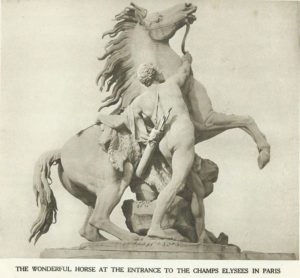
The Wonderful Horse at the Entrance to the Champs Elysées in Paris
I loved this book as a child, particularly for its range of topics: see the photo above. It even told me how to react to it – it was ‘wonderful’ – and I agreed. Arthur Mee was very good at the stirring stuff and I liked seeing objects or reading pieces which stirred my imagination.
*
A Captive’s Appeal to Caesar
‘If I had been betrayed and captured when the war began, neither my fortune nor my glory would have been so notable; I might have been put to death without attracting attention. But now, if you were to spare my life, I should be an example of Roman clemency for all ages.’
(The captive Caractacus to Claudius Caesar who set him free.)
*
Mee’s aim was to ‘educate the next generation’ and that is precisely what he did with me. Of course, I can see now that his agenda was rather different from what I had naïvely assumed it to be when I was a child. What interests me now is to see how limited his range of interests actually was. Basically, it was white, male, middle-class, Christian (preferably Protestant) and successful – though pagan philosophers from the Classical World are also allowed.
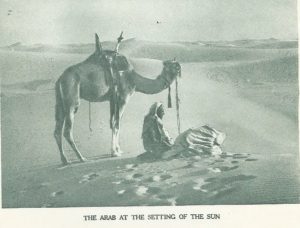
The Arab at the Setting of the Sun
Geographically, the book covers Western Europe, the Classical World, Ancient Egypt, and picturesque bits of the Middle East. Mee respected Islam, and the book includes several quotations from the Koran:
‘By the brightness of the morning and by the night when it growth dark, thy Lord hath not forsaken thee, neither doth he hate thee …
Did he not find thee an orphan, and hath he not taken care of thee? And did he not find thee wandering in error, and hath he not guided thee into the truth? Did he not find thee needy, and hath he not enriched thee?’ From the Koran.
*
The Victorian Arthur Mee (he was born in 1875) had a typically Victorian Nonconformist religious upbringing and saw Muslims as ‘People of the Book’ that is, they shared the teachings of the Old Testament with Christians and Jews, and, as such, were worthy of respect.
*
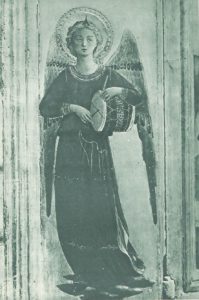
Fra Angelico’s Angel
Mee also had a strong belief in the British Empire as a force for good – under God’s guidance. Kipling may have written, as Mee reminds us, in Thy Mercy on Thy People, Lord – which was written while World War I was raging:
God of our fathers, known of old,
Lord of our far-flung battle-line
Beneath whose awful hand we hold
Dominion over palm and pine …
But two verses later Kipling then wrote:
Far called, our navies melt away;
On dune and headland sinks the fire
Lo, all our pomp of yesterday
Is one with Nineveh and Tyre …
In other words, as the Old Testament once-famous cities of Tyre and Nineveh fell into decay, so, too, might British power unless Britain behaves in Christian way towards her enemies.
*
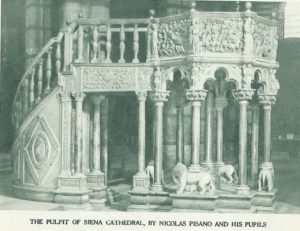
The Pulpit in Siena Cathedral by Nicolas Pisano and his pupils
*
Looking at IOOO BEAUTIFUL THINGS today, I am very struck by Mee’s omissions. There are no quotations from Jane Austen. for example, and Mrs Gaskell isn’t in the index, either. None of the British female fighters for Women’s Rights are mentioned. Oscar Wilde is conspicuous by his absence. Florence Nightingale, however, does have a couple of entries though, alas, Mrs Seacole has none. Abraham Lincoln has 9 entries in the Index, some of which mention his struggle to abolish slavery, but there are very few people of colour mentioned: Rabindranath Tagore has two entries and there is an anonymous Red Indian chief and I think that is all.
*
To see Florence Nightingale Pass By: a soldier’s letter from the Crimea
‘What a comfort it was to see Florence Nightingale pass by! She would speak to one and nod to another; she could not do it to all, you know, for we were lying there by hundreds, but we could kiss her shadow as it fell, and lay our heads on the pillow again content.’
*
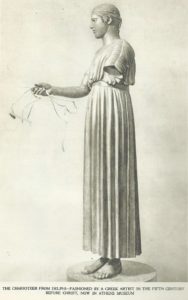
The Charioteer from Delphi – fashioned by a Greek artist in the 5th century B.C.
*
Furthermore, Mee’s ‘Britain’ appears to comprise only the English and the Scots; there are plenty of entries for Sir Walter Scott, Robert Burns, R. L. Stevenson, and one each for Robert Bruce and the Marquis of Montrose, for example. And, naturally, there are 30 entries under Shakespeare, and I have no quarrel with that. But there is nothing in the index referring to men and women from either Wales or Ireland; where is W.B. Yeats? What about some photographs of Welsh Bronze Age metalwork? There are, however, a number of American quotations and a number of interesting translations from the French, Germany, Latin and Ancient Greek writers and one from Persia:
*
Three Things from Old Persia
Three things the ancient Persians taught their children
From the age of five to the age of twenty:
To manage a horse well,
To shoot dexterously with the bow,
To speak the truth.
But I very much doubt that this included girls.
*
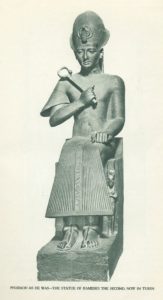
Statue of Rameses II, now in Turin
*
However, for all Mee’s faults and omissions I have a lot to thank him for. I imbibed a huge amount of general historical and cultural knowledge from IOOO BEAUTIFUL THINGS and – even though I might wince nowadays at my youthful love of the stirring and sometimes sentimental poems, letters, speeches, epitaphs, deathbed scenes, love letters and eye witness accounts of key moments in British history – I loved many of the quotations and the photographs, too.
I regret that he didn’t see fit to include a Benin bronze, for example, or a photograph of the Taj Mahal, but, as L. P. Hartley put it: ‘The past is another country, they do things differently there.’
I can only tell you, truthfully, how it was for my childhood self.
All the photos come from IOOO BEAUTIFUL THINGS
Elizabeth Hawksley
Please share this page...
What a wonderful book! I’ve never heard of it, but shall certainly look it up. I understand your change of viewpoint, and indeed things were done differently in the past. Don’t you think Mee merely reflects his world as he then knew it and was passing this on to children? We have a much more versatile outlook in this day and age which one would not expect from a man of that era. From your account there are surprising inclusions, from Islam and others. It is strange not to include Indian culture since at the time it was part of the British Empire.
Thanks for introducing me to what looks like a treasure trove of fascination.
There seem to be a lot of copies around, mostly Hodder & Stoughton from forties and fifties. The second hand bookstores have several, both with dust jacket and without. Can you tell me what year your edition is? Thanks!
I have no idea what date my edition is, there are no dates at all at the front or the back of the book. I only learnt that it was published in 1925 after I googled it to find out! I hope you find a nice copy – I don’t think you’ll be disappointed with it.
Thank you for your comments, Elizabeth. I agree with you that Mee was a man of his age who saw the world through white, English with a dash of Scottish lenses. I, too, was a bit puzzled as to why there was almost nothing from India – the jewel in the crown, after all, but decided that it might have been concern about Hinduism and possible lax morals – as he saw it.
I do wish I’d had your book, Elizabeth, instead of the Arthur Mee I unearthed in a cupboard in our house when I was small. It was a book of improving tales: in one a little girl loves a ring so much that she has to throw it away and confess her sin to her mother; in another, a boy secretly tries out his father’s razor and scars himself for life. Arthur definitely had his dark side! Fortunately my older sister found me scaring myself to death over this moralising tome, and read out some of the stories to the rest of the family to such howls of derision that I didn’t have nightmares. I’d have loved to know about the Persian children though – fascinating.
Good Heavens, Prem, how ghastly! I wonder what the book was – it doesn’t actually sound like Arthur Mee, who prefers to find the good side in people. He tends to have elevating small articles about someone doing an enemy a good turn in No Man’s Land – that sort of thing. Still, full marks to your sister for finding a way to turn the moral stories’ pernicious effects from horror to derision.
Yes, unfortunately we can’t help but further our own agenda and sometimes we don’t even realise that we do.
We really do need another pair of eyes to look at our work from time to time.
Thanks as usual for sharing your thoughts.
Thank you for your thoughtful comment, Huon. Arthur Mee was a man of his time and, whilst I deplore his unconscious sexism and racism, I have to say that he was, in his way, on the side of the angels. He believed in treating others as you would like to be treated yourself; he was anti slavery; he celebrated love and kindness wherever he found them; these are all worthy things.